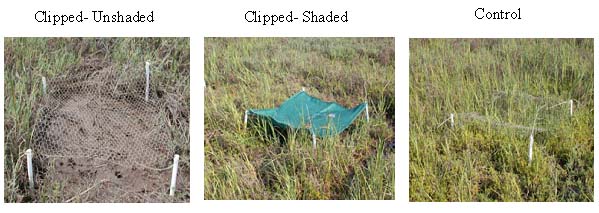Current Research: The objective
of this ongoing section of my research (funded as a portion of Levin
Lab SeaGrant) is to 1) test the hypothesis that benthic diversity
and soil food web in a Spartina foliosa marsh vary by presence or
absence of aboveground vegetation and 2) to evaluate the mechanistic
effects of light and aboveground structure. I used field manipulation
of light levels and aboveground plant structure to determine whether
vascular plant interactions with the benthic microalgal and invertebrate
communities were associated with shading effects or with structural
effects. Three treatments were established. These treatments were
(1) Clipped - Unshaded, 2) Clipped - Shaded, 3) Control - Unshaded.
Clipping and shading treatments isolate the effect of reduced light
condition from the effect of aboveground plant structure on both
the microalgal and infaunal communities.

The clipping and shading manipulations revealed that Spartina foliosa
exerts strong influence on abiotic environmental factors (salinity,
water content, and temperature at the soil surface) that mediate
changes in the biotic community. The infaunal community in unshaded
treatments resemble communities seen in a newly restored marsh;
unshaded treatments had lower species richness, a larger proportion
of insect larvae and a smaller proportion of annelids than when
plants remain (control) or their shading effects were mimicked (shaded).
This experiment demonstrates the dramatic effect of light reduction
by the vascular plant canopy on the abiotic environment as well
as on the infaunal community.
|
| Other Research Interests: Wetland ecology
- Community structure, Invasive species, Biodiversity. Specifically,
I am interested in the direct and indirect mechanisms by which wetland
vascular plants affect the microenvironment, physical structure, and
food webs of the benthic infaunal and microalgal communities. Ultimately,
I hope to understand the factors controlling variation within and
among wetlands and apply this science to restoration and conservation.
|
| Professional Experience: Abstracts:
Response of benthic communities to changing
flushing regimes in a Southern California lagoon
The Southern California coast is dotted with coastal lagoons
and embayments. Typically, geographically small with episodic freshwater
input linked to rain events, these lagoons also receive significant
inputs of energy, nutrients and organisms from the sea. Occasionally,
lagoons close for extended periods or during specific reproductive
seasons, possibly causing key species with life cycles dependent
on ocean flushing and transport to disappear. Because plant cover
is a main source of spatial heterogeneity in Pacific coast wetlands,
changes in plant community can influence the abundance and diversity
of benthic invertebrates. The objective of this research was to
determine responses of the seagrass, Ruppia maritima L. and associated
benthic communities to changing ocean flushing conditions in San
Dieguito Lagoon.
San Dieguito Lagoon contains approximately 260 acres of wetland
habitat that forms the lower part of the San Dieguito River valley.
This lagoon opens and closes regularly based on rainfall amounts
and flood scour. In October of 2002, San Dieguito River inlet was
breached after an extended 8-month closure. The lower salinity,
higher temperature water that resulted post-breach coincided with
changes in abiotic sediment properties, with changes in plant distribution,
and with changes in the benthic invertebrate community. Pre-breach,
tidal flats were dominated by R. maritima but were largely unvegetated
after opening the inlet. With the significant decrease in R. maritima
cover, porewater salinity increased, porewater temperature decreased,
and sediment redox values became more positive. Multivariate analysis
indicates differences between pre- and post-breach seagrass fauna
composition, partially due to increases in opportunistic species,
such as Capitella capitata complex. After breaching the inlet, the
seagrass infauna communities also exhibited an increase in diversity
and evenness. Understanding the benthic community alterations due
to changes in plant cover and in flushing regime will increase knowledge
of complex wetland interactions and aid conservation of Southern
California lagoon ecosystems.
Salt marsh vascular plant regulation of microalgal and infaunal
community structure
Changes in plant cover are a feature of many disturbed
wetland habitats (i.e. through wrack deposition, invasion, creation
or flushing changes). This work is designed to identify the role
of plant cover in wetland trophic functions. Previous studies of
animal gut content analysis and isotope analysis suggest that the
microalgae are the primary food source of macrobenthos in early
successional stages of Pacific salt marshes, while Spartina foliosa
detritus is used in later stages. In this experiment, we manipulate
light and plant cover to determine how vascular plants interact
with the benthic microalgae and invertebrate communities. Clipping
and shading manipulations, designed to mimic the effects of vascular
plant presence and absence and their shading effects, revealed that
plants exert strong influence on abiotic environmental factors (salinity,
water content, and temperature at the soil surface) that mediate
changes in the biotic community. In the absence of plants, soils
exhibited higher temperature and salinity, and lower water content
than those in unclipped controls or shaded patches. The algal mats
experienced greater mortality in the unshaded treatment and increased
thickness in the shaded plots whose plants were removed. Early successional
stage infaunal communities resembled communities seen in an early
stage marshes; they had lower species richness, a larger proportion
of insect larvae and a smaller proportion of annelids than when
plants remain (control) or their shading effects are removed. This
experiment demonstrates the dramatic effect of light reduction by
the vascular plant canopy on the abiotic environment as well as
on the infaunal community. This research will help elucidate the
trophic ecology of salt marsh animal communities in general and
the implications of changing plant cover associated with marsh restoration
or plant invasion.
|

